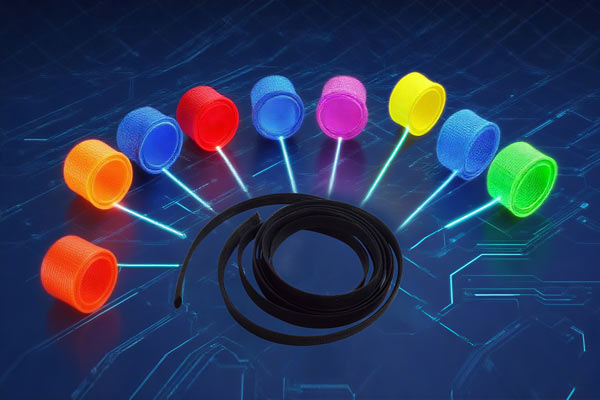Color in Industry Is Not About Style—It's About Strategy
When it comes to wire harness protection, color is more than just an aesthetic choice. In fact, color plays a critical role in durability, performance, and cost control.
Across automotive, industrial, energy, and electronics sectors, black cable sleeving has become the overwhelming standard—while white, gray, and colored options remain niche. Why?
Let’s explore the industrial logic behind this trend—the economics of color in sleeving—and how black emerged as the most practical, versatile, and cost-effective option.

1. Why Black Sleeving Is the Industry Standard
1.1 Superior Dirt and Stain Resistance
Black hides oil, dust, and grime far better than any other color. In harsh environments such as engine compartments, electrical substations, or factory floors, this reduces the need for frequent cleaning and ensures equipment looks reliable even after extended use.
1.2 UV Resistance Through Carbon Black
Most black PET or PP sleeves are blended with carbon black, a powerful UV stabilizer that significantly improves resistance to ultraviolet aging. This makes black sleeving ideal for:
Automotive engine bays
Solar installations
Outdoor enclosures
Other colors often lack this built-in UV protection unless enhanced with expensive additives.
1.3 Neutral & Universally Compatible
Black is a neutral color that matches with all wire insulation colors, connectors, and components. It blends into virtually any assembly design without looking inconsistent or out of place.
1.4 Lower Material and Production Cost
Black PET and PP materials are:
Cheaper to produce and dye
More readily available in the market
Easier to process at scale with fewer defects
These factors make black the preferred choice for mass production and standardized supply chains.
2. Why Colored Sleeving Is Rarely Used
Despite its visual appeal and signaling potential, colored sleeving is used far less often, primarily due to performance and cost disadvantages:
2.1 Poor Dirt Resistance
White and light gray sleeves quickly show signs of contamination in industrial settings. Cleaning them is difficult, and their appearance degrades over time.
2.2 Weaker UV Aging Performance
Unless enhanced with stabilizers, colored sleeves are more vulnerable to fading, cracking, and brittleness under sunlight and heat.
2.3 Limited Demand for Color Identification
Colored sleeves (red, blue, yellow, etc.) are useful for circuit identification, voltage levels, or signal types, but are mostly limited to custom, low-volume orders.
2.4 Higher Inventory & Production Cost
Managing multiple colors increases manufacturing complexity:
More frequent color changeovers
Higher scrap rate
Increased warehousing and SKU management
In contrast, black allows simplified inventory and stable high-efficiency production.
3. Where Colored Sleeves Still Matter: Niche Use Cases
Though less common, colored sleeves serve critical signaling roles in specific applications:
| Color | Typical Use Cases |
| Red | High-voltage lines, alarms, positive terminals |
| Blue | Network cables, signal wires, negative terminals |
| Yellow | Warning or safety controls |
| Gray | Medical equipment, data centers |
| White | Medical gear, indoor visible routing |
| Transparent | Visual inspection, demonstration purposes |
Black Is the Optimal Industrial Color
The popularity of black in cable sleeving is not accidental—it's the result of years of industry experience, material science, and practical economics. Black offers:
The best UV resistance
The strongest dirt masking
The most cost-effective and scalable production
Universal aesthetic and functional compatibility
Colored sleeving has its place—but mostly as a complementary solution for special needs, not a core material for volume production.


